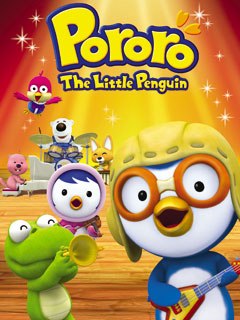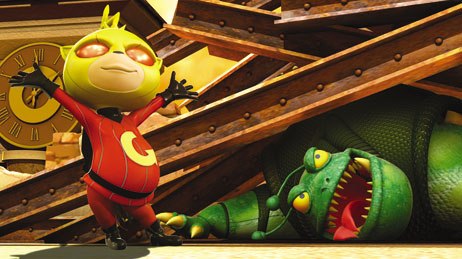The former work-for-hire power transitions into a source of proprietary animation for the global market.
Around 2000, the Korean animation industry, then known almost exclusively as an animation service provider, began to develop proprietary productions and co-productions for the world market. While it has faced many challenges along the way, it is starting to have some global success, including with two preschool series, Dibo the Gift Dragon and Pororo the Little Penguin.
"Up until early 2000, a lot of Korean animation studios relied heavily on work for hire from the U.S.," says Paul Lee, licensing and international relations manager at Ocon, a Korean animation house. "It was around that point in time that Korean studios began to realize the importance of creating their own properties. And it was also around that point in time that the work for hire from the U.S. decreased dramatically due to the emerging of competitors from Asia (India, Vietnam, China, etc.), whose price Koreans just weren't able to compete with."
Korea has the third-largest animation industry in the world behind the U.S. and Japan, according to the Korea Culture & Content Agency (KOCCA), an organization that promotes Korean animation and gaming. About 100 animation studios, many small- to medium-sized, belong to the major Korean producers' associations.
A Period of Evolution
Many Korean studios have begun to have strong sales of proprietary properties to domestic television stations, which have been supportive of local TV productions. Iconix Ent., which coproduced Pororo with Ocon, has sold not only Pororo locally, but other shows as well, according to Wonjung Kim, sales manager. They include Chiro, which airs on the Educational Broadcasting System (EBS), and Taichi Chaser and Petit Petit Muse, which run on the Korean Broadcasting Service (KBS). Because there is no exclusivity in broadcast sales, the top shows tend to appear on several channels. Pororo is on 13 local stations, Dibo on eight, and Z Squad, a show from Enemes Animation, on seven.
Korean studios also have sold their properties in many countries across Asia. But Asia is experiencing economic difficulties and is becoming a more difficult venue for TV sales. At the same time, Europe is emerging as a more significant market for Korean shows, as Dibo and Pororo demonstrate. They have been particularly successful there, although they have been sold into many countries around the world.
Iconix handles TV sales and licensing for Pororo worldwide. The show has been sold into 80 countries, appearing on TF1 in France and Cartoon Network in the U.K., among others. Meanwhile, Ocon's Dibo has been sold in a variety of international markets, including to Canal J in France, Disney Channel in Latin America and Southeast Asia, Nickelodeon in India and the Netherlands, RAI 2 in Italy, YoYo TV in Taiwan, MediaCorp TV12 in Singapore, Al Jazeera Children's Channel in the Middle East, and the HOP Channel in Israel.

The U.K., U.S. and Japan remain difficult markets for Korean studios to crack. But there have been a few success stories in these territories as well. In addition to the U.K. sale of Pororo, Eon Kid (Iron Kid), a coproduction of Designstorm and Daewon Media (Korea), BRB International (Spain) and Manga Ent. (U.S.), premiered on the CW's Kids WB block in 2007, while Sunwoo's MixMaster, based on a trading card game, is on the air in the U.K. and Japan.
As is true for animation companies around the world, Korean studios are trying to do a mix of projects, including proprietary and work for hire, television, film and videogames. Seoul-based Enemes has produced 26 episodes of Z Squad, its first original project for the world market -- the show is airing in Asia now, with Nelvana handling rights in other territories -- and has developed another property, Garlic Boy. It also is working on videogame projects for Asian companies and recently did a test for EA, according to Marlene Sharp, the house's U.S.-based producer and manager of distribution and marketing.
Similarly, SamG Animation of Seoul built its business on service work, TV coproductions for the Korean market, and cinematics and cut scenes for Korean online games, according to producer Michael Diaz, who consults for SamG. The studio currently is in production on My Giant Friend, coproduced with Timoon Animation of France, and is developing other proprietary series, including Vroomies, The 7 C's, and an untitled comedy. It also is producing animation for T5, a coproduction of HIT Ent. and Korean studio Cocaban, on a for-hire basis.

Overcoming Challenges
One of the barriers facing Korean studios is the higher cost of animation there, compared to other countries where outsourcing is done. "There's a reason things cost as much as they do in Korea," Diaz explains. "They take lots of pride in their work and they set a high bar with quality. Their experience shows from the ground up."
"We submit bids and do tests all the time," says Enemes' Sharp. "But [western studios] want us to work for the same wages as the Indian studios work for. Korea is not a third-world country any more. The quality has improved and prices have gone up a lot." She points out that some work ultimately comes back to Korea to be fixed or finished, after having been in India or another country.
On the proprietary side, Korean studios historically have had a reputation for creating properties that are good-looking, but lack character development and storyline. While in the West an animated property starts with a concept and story, in Korea the genesis often is a cute character that begins as a licensing property. Recent examples include Vooz's Pucca and SLKO Ent.'s Mashimaro.
A disconnect also can exist between the Korean and Western visions of what makes a solid entertainment property, especially for children. In some cases, Korean shows have more sex and violence than is permissible on U.S. networks, for example. There also can be cultural references that are unfamiliar to American audiences.
While many of these differences can be eliminated in reversioning or sent back for changes, there often are structural differences between Western and Korean shows that need to be addressed up front. "I've seen a lot [of shows], and a lot need more tweaking," says Sharp, who notes that the original scripts aren't bad, but have a distinctly Asian style that doesn't always translate to the West. "My boss is like the David E. Kelley of Korea, but he didn't even know about the three-act structure," she says.
The nature and business practices of the Korean animation industry also can present challenges. Jeff Segal, president of Magic Lantern Ent., who previously was president of Universal Cartoon Studios and before that executive VP at Hannah-Barbera, notes that studios in Korea pop up and fizzle out quickly, causing good, trusted animators to move on, never to be found. "They're gypsies," he says. "Work dwindles and they scatter, and it's hard to keep track of them."
Funding issues can be difficult as well. Observers report that some Korean studios are looking for 100% financing from the U.S., in amounts of $3 million to $10 million, which is unrealistic. Meanwhile, Korean government-backed animation funds often have rules and regulations that are unattractive for Western investors.

A Positive Outlook
The industry is starting to overcome many of these barriers. Korean studios are increasingly hiring U.S.-based consultants, writers, storyboard artists and producers to flesh out their original concepts. In a few cases, they're even acquiring Western properties, such as comic books, or optioning scripts from U.S. creators. SamG has a deal with Man of Action, the four-man writing team behind Ben 10, for example, and Diaz points out that My Giant Friend is the last SamG property without American talent involved.
"It's collaborative, with notes and comments sent back and forth, and [the Korean studio is] very involved in the characters and stories," Diaz says. "It's their property, they're financing and paying for it. But now we agree that if there's a disagreement, we'll go with the U.S. sensibility. They're more inclined to do that now. Over the last five years there's also been a better understanding and awareness of each other's culture. It's all about communication and continued conversation." Diaz points out that Korean companies attend all the major markets now, not only sales-focused events like MIPCOM or MIPTV, but also conferences such as Comic-Con, Wizard World and KidScreen, where they can network, meet fans and talent, and learn.
Some Korean studios are aligning with Western studios for long-term partnerships. L.A.-based Magic Lantern Ent. has a strategic alliance with ORG Studios in Goyang City, a media center outside of Seoul. The venture, called the Korus Group, is developing two of ORG's properties, Psikix and Rainbow Kitties. Magic Lantern also is working with other Korean studios on an ad-hoc basis, including Independent Creative, with which it is developing one of the latter's properties, Aco & Dinga, and one of Magic Lantern's originals, Cartoon Classics.
"There's a lot of investment in infrastructure in Korea," Magic Lantern's Segal reports, noting that giant communications companies in particular are financing animation studios and helping them establish large facilities. The Korean government is active in developing media megacenters, where local broadcasters, U.S. studio divisions, live-action producers and animation houses all coexist.
Probably the biggest advantage Korea has on the world market is its reputation for quality. "They are highly technologically advanced," Segal says. "In other Asian countries, the 2D shops are trying to adapt to a 3D world. But the Koreans were quick to move into 3D, and there is some very good CGI animation from Korean shops today. They can do Pixar-quality work when given the budget."
"The art that is coming out of Korea is amazing," agrees Jan Nagel, the Entertainment Marketing Diva, who formerly consulted with KOCCA. She says about half of the properties she saw as she evaluated KOCCA members' work were appropriate for the world market, with the remainder relevant mainly for Korea and neighboring Asian countries only. But all had one thing in common: "The artwork is just breathtaking."
"Koreans are very fast-paced and very trendy in terms of lifestyle," says Ocon's Lee. "And this is well reflected in the animation industry. 3D is dominant over 2D and stop motion, and Koreans are always experimenting with new ideas and concepts. Dibo is a good example of this, with its unique texture and feel incorporated in the animation."
Feature Films
The Korean animation industry has been recognized primarily for CGI done for television, but many observers see feature films as the next horizon. Some Korean films, such as Yobi the Five-Tailed Fox, Robot Taekwon V and Mug Travel, have done well at the domestic box office recently. And, Diaz believes, Korean studios' experience with creating high-quality 3D animation for American television means they would be able to complete film projects for Western studios under budget and ahead of schedule. "They desperately want to be in the feature business, either through service or with their own properties," he says.
The Weinstein Co. has seen the potential for Korean feature production. It announced in mid-2007 that it was partnering with the Gotham Group and Chungcheongnam-do Province in Korea in a long-term strategic alliance to produce animated feature films. Variety Asia reported that the venture would produce six to 10 films with budgets of about $40 million each, with animation completed by a consortium of 30 CG animation companies. The first project under the pact is A Cricket in Times Square. Lionsgate has worked with Korean studios on features as well; the visual effects for The Forbidden Kingdom were completed in Korea.
"There's a tremendous opportunity for North American studios and distributors to work with Korean studios, and they're very open to using U.S. talent," Diaz says. "There's a lot of money there and they want to spend it."
Karen Raugust is a Minneapolis-based freelance business writer specializing in animation, publishing, licensing and art. She is the author of The Licensing Business Handbook (EPM Communications).










